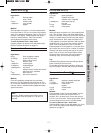
– 2 –
Microwave Recipe Preparation and Techniques
Covering
Covering food minimizes the microwave cooking
time.
Because microwave cooking is done with time and
not direct heat, the rate of evaporation cannot be
easily controlled. However, this can be corrected by
using different materials to cover dishes. Plastic
wrap is the best substitute for a lid as it creates a
tighter seal and so it retains more heat and steam.
Wax paper and paper towels hold the heat in but
not the steam. These materials also prevent
splattering. Use a paper towel, wax paper or no
cover when steam is not needed for tenderising.
Browning
Meats and poultry, when cooked longer than 10 to
15 minutes, will brown from their own fat. Foods
cooked for shorter periods of time can be aided with
the help of a browning sauce, worcestershire sauce
or soy sauce. Simply brush one of these sauces
over meat or poultry before cooking. Baked goods
do not need long cooking times and therefore, do
not brown. When cakes or cupcakes are iced, no
one will notice the visual difference. For cakes or
cupcakes, brown sugar can be used in the recipe in
place of caster sugar or the surface can be
sprinkled with dark spices before baking.
Standing Time
The moisture molecules continue to vibrate in the
food when the microwave oven has turned itself off.
After all, the molecules were vibrating at
2,450,000,000 times per second during cooking. So
cooking continues even after the food is no longer
being exposed to the microwaves whether in or
outside your microwave oven.
Standing time refers to the time it takes (after the
microwave time is completed) to allow the interior of
the food to finish cooking.
The amount of standing time varies with the size
and density of the food. In meat cookery, the
internal temperature will rise between 5°C and 10°C
if allowed to stand covered for ten to fifteen
minutes. Rice and vegetables need shorter
standing time, but this time is necessary to allow
foods to complete cooking in the centre without
overcooking on the edges.
The power level used in microwave cooking also
determines the standing time. For example, when
using a lower power level the standing time is
shorter because of a lower concentration of heat in
the food. Foods should always be kept covered
while standing in order to retain the heat. If a longer
standing time is required (while you cook another
food to serve with the first, for instance), cover with
aluminum foil.
Converting Your Favourite Conventional
Recipes for Microwave Cooking
When adapting conventional recipes for microwave
cooking, time are reduced considerably.
For example, A chicken which takes 1 hour to cook
in a moderate oven will take 15 to 20 minutes on P7
Power in your microwave oven.
Use similar microwave recipes to help you adapt
conventional recipes. Remember, it is always best
to undercook a recipe and then add an extra minute
or two to finish it off.
Here are some other tips that may help:
• Reduce liquids in a conventional recipe by one
half to two thirds, e.g. 1cup (250 ml) should be
reduced to
1
⁄2 cup (125 ml).
• Add more thickening such as flour or cornflour to
sauces and gravies if you do not reduce the liquid.
• Reduce seasonings slightly in a recipe where
ingredients do not have time to simmer by
microwave.
• Do not salt meats, poultry or vegetables before
cooking; otherwise, they will toughen and dry out.
• If one ingredient takes longer to cook than the
others, pre-cook it in the microwave oven first.
Onion, celery and potato are examples.
• When cooking meat or vegetables, omit any oil or
fat that would have been used in a conventional
recipe for browning.
• Reduce leavening agents for cakes by one quarter
and increase liquids by one quarter.
• Biscuits require a stiff dough. Increase flour by
about 20 percent. Substitute brown sugar for white
sugar and use biscuit recipes that have dark
spices or require icing. Because of the short
cooking time, biscuits don’t have time to brown.
Chill dough for half an hour before baking. This
produces a crisper biscuit. Bake biscuits on a
glass tray lined with greaseproof paper.
• Since microwaves penetrate foods about two
centimetres from the top, bottom and sides,
mixtures in round shapes and rings cook more
evenly. Corners receive more energy and may
overcook.
• Items with a lot of water, such as rice and pasta,
cook in about the same time as they would on a
conventional stove. (Refer to Rice and Pasta
chapter.)
Select recipes that convert easily to microwave
cooking such as casseroles, stews, baked chicken,
fish and vegetable dishes. The results from foods
such as grilled meats, cooked souffles or two-crust
pies could be less than satisfactory. Never attempt
to deep fry in your microwave oven.


















